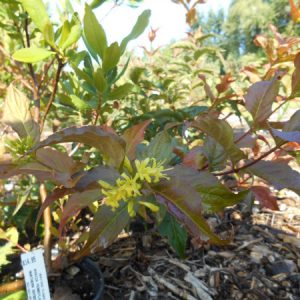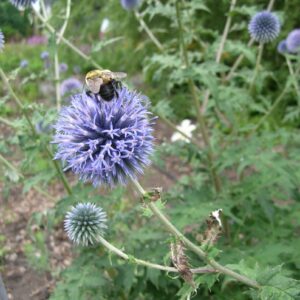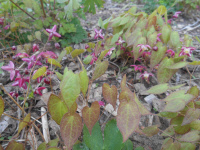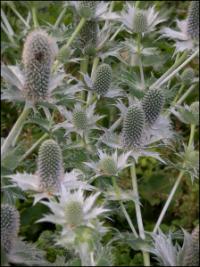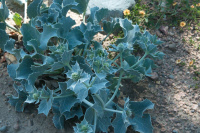Drought, Xeric & Dry Soil Plants
Showing 41–48 of 132 results
-
Diervilla lonicera Northern bush honeysuckle Z 3-7
Lemon yellow flowers on this short shrub June to August. In fall its foliage turns dark red for the final fireworks’ display. Great shrub for tough, dry shady areas.
Lemon yellow flowers on this short shrub June to August. In fall its foliage turns dark red for the final fireworks’ display.
Size: 3’ x 3’ spreading
Care: sun to part shade in well-drained soil, drought tolerant
Native: Eastern half of US & Canada, Wisconsin native.
Wildlife Value: nectar source for Bumblebees. Birds make nests from the branches and eat the fruitsUsed medicinally by numerous Native Americans – Algonquin, Chippewa, Cree, Iroquois, Menominee, Meskwaki, Ojibwa and Potawatomi. Used as remedy for sore eyes, diuretic, “old men who cannot retain urine,” constipation, stomach pain, increase breast milk, to “spoiled babies with adulterous mother,” STD’s and vertigo. Dr. N. Dierville, a surgeon, carried this to France from Canada (then Acadia) in 1699. Botanist to France’s king, Louis XIV, Joseph Pitton de Tournefort (1656-1708) named this to honor Dierville
**LISTED AS OUT OF STOCK BECAUSE WE DO NOT SHIP THIS ITEM. IT IS AVAILABLE FOR PURCHASE AT OUR RETAIL LOCATION.
-
Dryas drummondii Drummond’s mountain avens, Yellow mountain avens Z 3-9
Mat of leathery, wrinkled, creeping foliage, glossy green turning bronze in fall, oval with rounded teeth. From May through July leafless, erect flower stems rise 4-8” above the ground-hugging leaves, with nodding 8 to 10 buttercup yellow petals emerging from a fuzzy, decorative cup.
OUT OF STOCK
Mat of leathery, wrinkled, creeping foliage, glossy green turning bronze in fall, oval with rounded teeth. From May through July leafless, erect flower stems rise 4-8” above the ground-hugging leaves, with nodding 8 to 10 buttercup yellow petals emerging from a fuzzy, decorative cup.
Size: 6-10” x 12-24”
Care: sun in well-drained soil. Drought tolerant
Native: Alaska south to Washington east to Montana, most of Canada1st collected in seed by Sir John Richardson (1787-1865) Scottish naturalist on Franklin’s 1st overland expedition to the Arctic coast, 1819-1822. Franklin called the expedition “disastrous” but went again. Both Richardson and Thomas Drummond (1793-1835) collected this in seed and flower on Franklin’s 2nd overland expedition to the Arctic coast. (1825-1826) It is named to honor Thomas Drummond at Richardson’s request. Curtis’s Botanical Magazine v. 57 ser. 2 (1830). Richardson then led a 3rd expedition searching for Franklin’s last Arctic expedition, finding no trace of the lost ships or men.
-
Echinops ritro Globe thistle Z 3-9
Mid to late summer, round, steel blue flower heads at 1st prickly then turning soft and fuzzy. Great cut flower, fresh or dried.
Mid to late summer, round, steel blue flower heads at 1st prickly then turning soft and fuzzy. Great cut flower, fresh or dried.
Size: 3-4' x 18"
Care: Sun in well-drained soil, drought tolerant
Native: Southern Europe
Wildlife Value: attracts American painted lady butterflies, deer resistantThe name Echinops is Greek meaning “like a hedgehog” describing the circular spiny thistles. Introduced to England by 1570. Popular Victorian flower. Cultivated by Washington at Mount Vernon.
-
Epimedium x rubrum syn. Epimedium alpinum var. rubrum Red barrenwort Z 4-8
small, star-shaped, rosey-red flowers dance on the ends of wiry-thin stems
OUT OF STOCK
In mid-spring small, star-shaped, rosey-red flowers dance on the ends of wiry-thin stems about one foot high. Red-flushed foliage follows the flowers, the more sun, the more red on leaves. Wonderful groundcover. Cross between Epimedium grandiflorum and Epimedium alpinum
Size: 16” x 24” slow spreading
Care: Sun to shade in most any soil but best in part shade – one of most adaptable plants
Wildlife Value: deer resistant
Awards: Elisabeth Carey Miller Botanic Garden Great Plant Pick1st described in 1853 in Belgique Hort. iii. 33. I. 6.
-
Erigeron compositus Cutleaf daisy, Dwarf mountain fleabane Z 3-8
Cushion shaped plant with wooly grey leaves topped by small bluish, pink or white rays like a daisy with a yellow center. Flowers in June-July.
OUT OF STOCK – PLEASE EMAIL FOR AVAILABILITY
Cushion shaped, midget plant with wooly grey leaves topped by small bluish, pink or white rays like a daisy with a yellow center. Flowers in June-July.
Size: 6” x 6-12”
Care: sun to part shade in well-drained soil. Drought tolerant.
Native: all of western No. America from prairies to alpine slopes.Erigeron comes from Greek er meaning “spring” and geron for “old man” due to some of these species having white downy hair like an old man.
Thompson Indians from British Columbia chewed on the plant then spit on sores to remedy skin ailments. They also made a decoction of the plant, mixed with any weeds for broken bones. Collected by Meriwether Lewis in late spring 1806 near today’s Lewiston Idaho. -
Eryngium giganteum Miss Wilmott’s ghost SELF-SEEDING BIENNIAL Z 5-8
In summer, oval thistles top prickly green, turning steely blue, silvery, bracts – very ornamental.
In summer, oval thistles top prickly green, turning steely blue, silvery, bracts – very ornamental.
Size: 36" x 24"
Care: Full sun in moist well-drained, fertile soil. Be sure to let it drop its seeds & do not weed seedlings out the following spring.
Native: Caucasus Mountains
Awards: England's Royal Horticultural Society Award of Merit.Eryngium is Greek for thistle. Introduced to England in 1820. Miss Ellen Willmott (1858-1934), a wealthy, eccentric English gardener reputedly dropped seeds as she passed her neighbors’ gardens. The plants came up afterwards, her “ghosts.” Recommended by Gertrude Jekyll in 1908.
-
Eryngium maritimum Sea holly Z 5-10
Round thistles turning steely blue in July-August atop silver colored, prickly bracts. Attractive ivy-shaped prickly foliage.
OUT OF STOCK
Round thistles turning steely blue in July-August atop silver colored, prickly bracts. Attractive ivy-shaped prickly foliage.
Size: 12" x 10" slowly spreads
Care: Full sun in well-drained soil.
Native: Seacoasts of Europe“Eryngium” is Greek for thistle. Anglo-Saxons prescribed Sea holly root to cure the king’s evil, serpent bites, broken bones, stiff necks and melancholy. Also considered an aphrodisiac and brought on “kissing comfits.” This was identified by Dioscorides in De Materica Medica for medicinal use around 70 A.D. Eryngium was described in Gerard’s Herball in 1597 for its uses:” old and aged people that are consumed and withered with age, and which want natural moisture (and also) amended the defects of nature in the younger,” William Robinson, father of the mixed perennial border, considered this plant “very pretty.”
-
Eryngium planum Flat sea holly Z 5-9
Round thistles top prickly steel blue, silver colored, bracts June-August. Stems turn steel blue too. Deadhead for repeat bloom. Reseeds readily. Great cut flowers: dry or fresh…
Round thistles top prickly steel blue, silver colored, bracts June-August. Stems turn steel blue too. Deadhead for repeat bloom. Reseeds readily. Great cut flowers: dry or fresh.
Size: 36” x 18”
Care: Sun well-drained soil, drought tolerant
Native: E. EuropeEryngium is Greek meaning “thistle.” Described in Gerard’s Herball in 1597 for its uses to remedy: “old and aged people that are consumed and withered with age, and which want natural moisture (and also) amended the defects of nature in the younger.”

